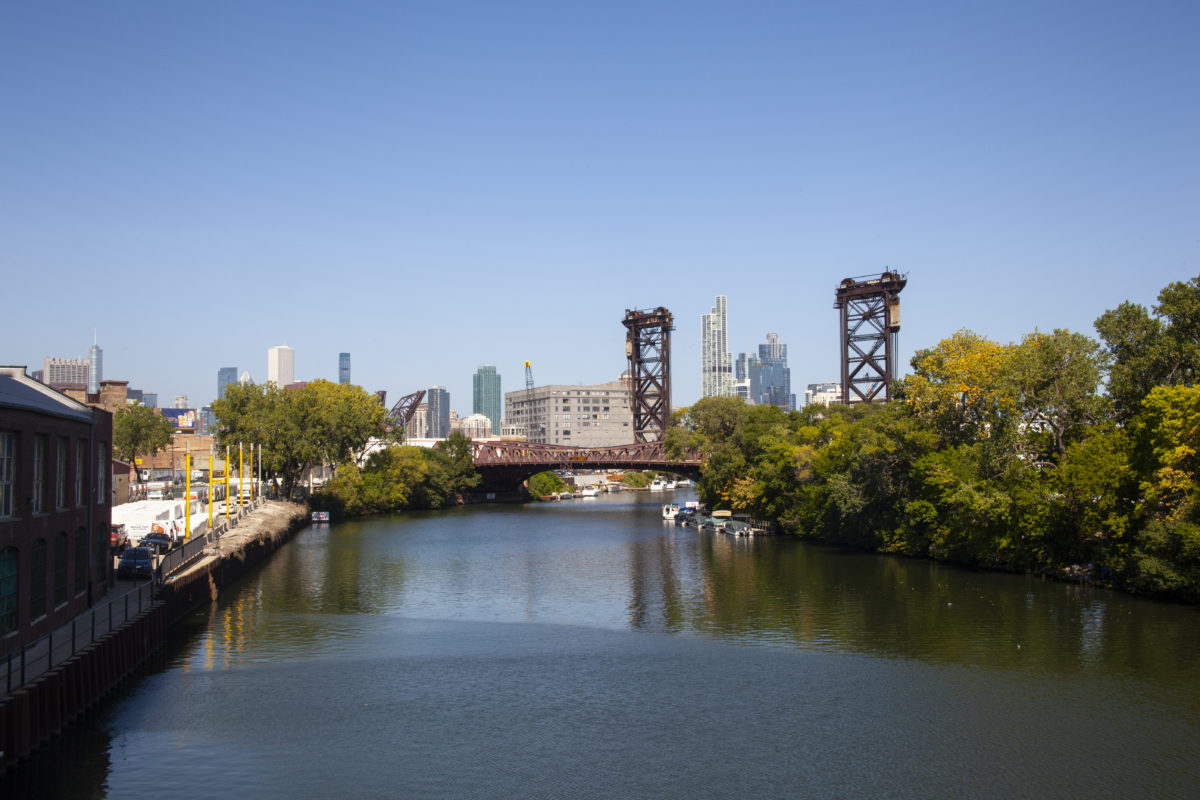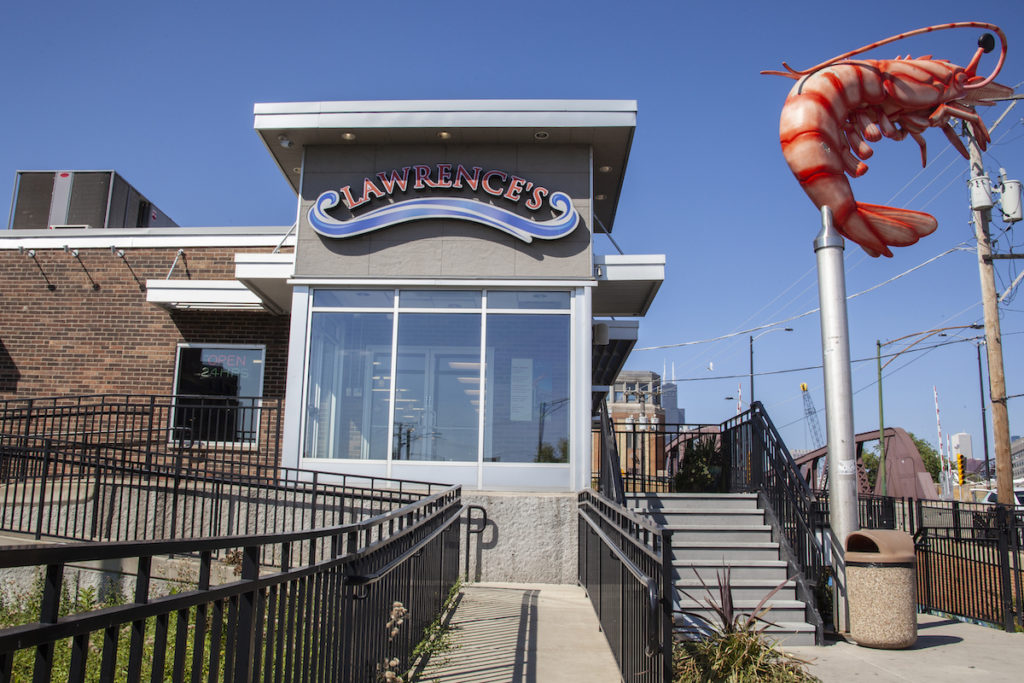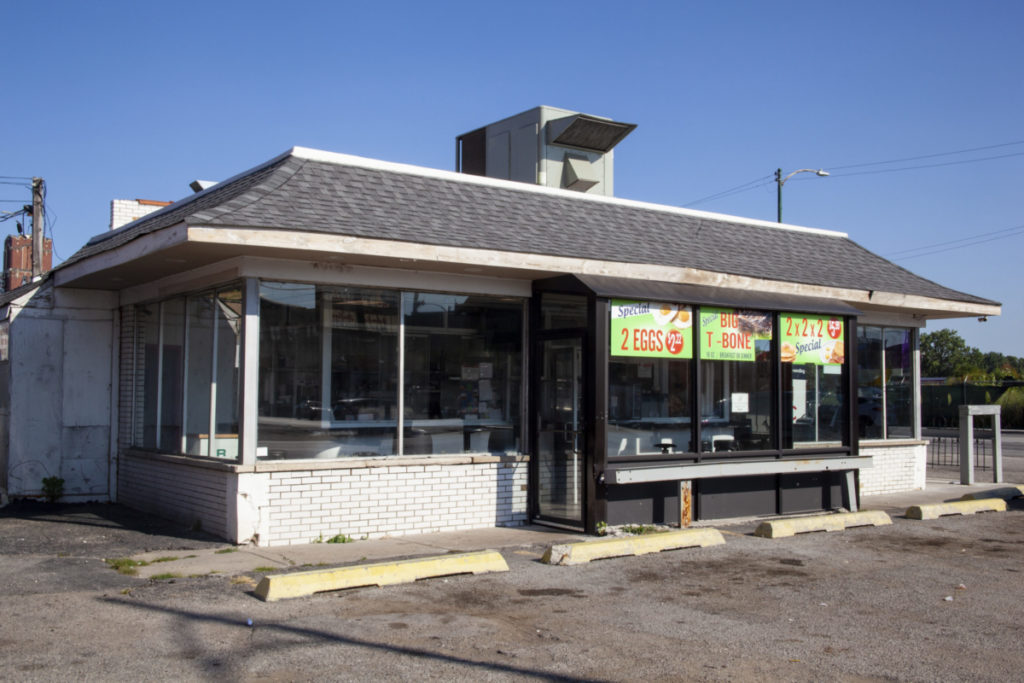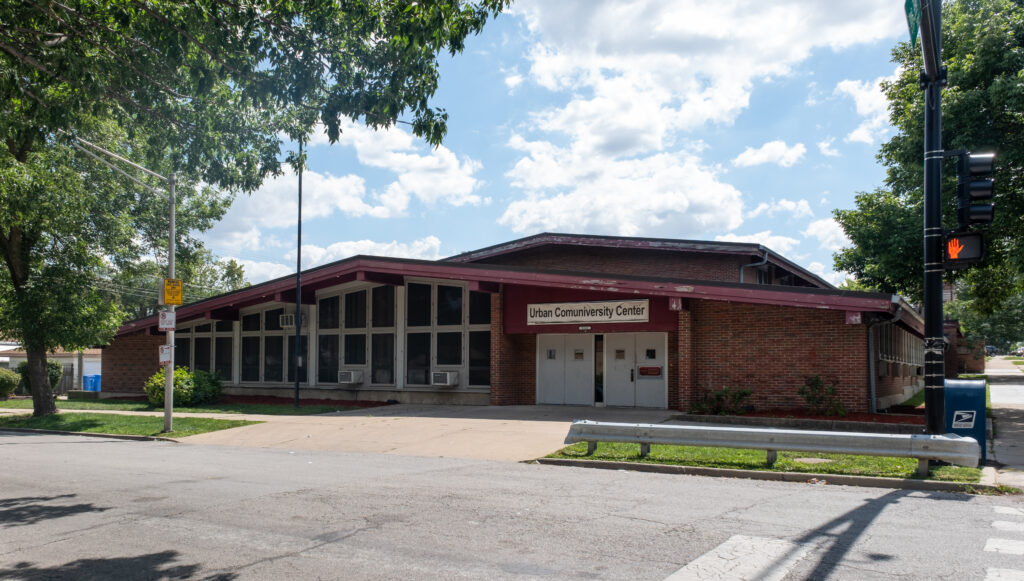- Best Youth Center on Jeffery: Urban Comuniversity Center — Calumet Heights
- Best After Dark Destination: Kevin’s Hamburger Heaven
- Best Designed Park: Fuller (Melville) Park
- Best Fishing: Park 571
- Best Shrimp Shack: Lawrence’s Fish and Shrimp
Portside, right off the lake, down by the river, just over a bridge and off the train tracks: Bridgeport and Canaryville, a bridge to the South Side.
This place has been shared, and divided, between different nations and nationalities for millennia. The Ojibwe, Odawa, and Potawatomi nations had lived, and live, on this land. In the earliest days of the nineteenth century, settlers set up an outpost, claiming the land as “Hardscrabble.” And in 1836—in the wake of the devastation wrought by the Black Hawk War—it became Bridgeport. From its earliest days, Bridgeport was home to working-class immigrant communities—the Irish, Italian, Polish—that were integrated into whiteness as the years passed. At times, it was an enclave, guarded by racist violence and ruled by the Daleys. Yet that is changing: the neighborhood is now one of the most diverse in the city, and is overseen by Nicole Lee, the City’s second-ever Asian-American alderperson.
In this neighborhood you can find art, culture, and cuisine on every street corner and under every street lamp. Make your way to 26th and Wentworth, the last stop before Chinatown—the smell of neighborhood food lingers. All along Archer Avenue, the roots of this city run deep. On Halsted from 31st to 35th, there are restaurants galore, and from there, it’s a straight shot to beautiful Canaryville. Since 1925, the Stock Yards Bank has remained on Halsted and Root Street, the last remnant of the meat packing industry.
Parks and native plant life keep the Canaryville spirit alive—each tree has its own history, and still houses the sparrows which the neighborhood was named after. Fireworks from old Comiskey still echo through the streets. Bridgeport and Canaryville, Chicago’s original grounds.
Note 10/26: The introduction was updated to make small factual corrections and to more intentionally represent the area’s Indigenous history.
Neighborhood captain Santino Napolillo is just a Chicago artist doing his part to help save the world.
- Best Breaded Steak Sandwich: Ricobene’sby Joseph S. Pete
Ricobene’s, a resolutely old school purveyor of pizza and other Italian cuisine, has been a Bridgeport institution since 1946. This longevity is no happenstance: it has a claim to fame, the breaded steak sandwich one can find at only a few Bridgeport joints.
USA Today writer Ted Berg proclaimed Ricobene’s breaded steak sammy “the best sandwich in the world,” calling it “a perfect sandwich,” declaring that he was “unwilling to believe there is any sandwiches distinctly better than this one,” and that it’s one’s “duty to sing the gospel of breaded steak to the people.” The late, great Anthony Bourdain featured it on his CNN show Parts Unknown, proclaiming it as “something that everyone should be proud to have on their flag.”
Anticipation builds as you enter the vintage, delicatessen-like restaurant with checkerboard tile, walls cluttered with historic photos, and dark wood pillars flanking the counter. You put in your order, grab a wooden chair at a table, and wait for the meaty miracle that Eater branded one of “Chicago’s essential sandwiches.”
Believe the hype. The monstrosity of a sandwich combines breaded skirt steak folded like a New York slice, chunky marinara, ooey-gooey strings of melty mozzarella and crisp, tangy giardiniera in a Turano french roll that’s crusty on the outside and soft on the inside. It’s a massive sandwich many can’t finish in one sitting. It’s a sandwich that evokes the old Chicago: the Union Stock Yards, South Works, superfans accents.
Ricobene’s menu also features the usual roster of Chicagoland favorites: Italian beef, Italian sausage, the combination thereof, pepper and egg sandwiches, rib tips, dogs run through the garden, and Chicken Vesuvio sandwiches. The vintage joint offers many Italian dishes like mostaccioli, antipasto, and pizza galore, including by the slice and a breaded steak pizza with red gravy, mozzarella, and bite-sized pieces of the iconic breaded and fried steak.
Rosaria and Antonia Ricobene started the business 76 years ago, when they launched a produce cart just after World War II. They turned to hot meatball and sausage sandwiches in the winter months when fewer vegetables were in season.
The second generation of the restaurant’s family ownership—Sam, Frank, and Russell Ricobene—crafted the gargantuan sandwich Ricobene’s became known for. It’s sloppy, the “kind of lunch you under if you’re OK with getting a little red sauce on your shirt,” according to the bygone DNAinfo. The wrapper, the edges of your smudged lips, and the napkin will be kissed with crimson. Other South Side restaurants, including Ferro’s and Fabulous Freddie’s on 31st, have their own versions, but Ricobene’s breaded steak sandwich is the one that’s won national acclaim, and for a reason.
Ricobene’s, 252 W. 26th St. Sunday, 10am–12am; Monday–Thursday, 9am–12:30am; Friday 9am–2am; Saturday, 10am–2am. (312) 225-5555. Ricobenespizza.com.
- Best Shrimp Shack: Lawrence’s Fish and Shrimpby Sofia McDowell
Commercial fisherman Lawrence Schweig always dreamed of working for himself. So after a long and successful career, he ventured on his own and opened a tiny storefront. Even before it became the restaurant we know today, the fishery was known for harvesting the best fish in Lake Michigan, and providing fresh and smoked fish to hotels and restaurants across the city.
Lawrence’s Fish and Shrimp has been a Chicago staple for over seventy years, but especially for the South Side neighborhoods immediately adjacent to this traditional fishery, such as Bridgeport, Canaryville, East Pilsen and Chinatown.
As the demand for Lawrence’s fish grew over the years, four new items were added to the menu: fried shrimp, perch, frog legs, and chicken. Soon, the small establishment would open its doors 24/7—but it wasn’t until the 1980s that the small establishment expanded to open more locations.
Today, the original location continues to sit at the edge of the South Branch of the Chicago River, providing a soothing view of the water. Whether you are in for a quick bite or a late night basket of fried shrimp, Lawrence’s Fish and Shrimp is the way to go.
This is your sign to stop by and enjoy the Canal Street patio, a cold beer, and some out-of-this-world fried seafood and chicken.
- Best Fishing: Park 571by Santino Napolillo
Park 571 is located along the South Branch of the Chicago River, right where Bubbly Creek splits off to the south. This water-based recreational park contains a launch spot for canoes and kayaks, and a two-building boathouse facility designed by local celebrity architect Jeanne Gang. Quest Biscuit, a tour agency, offers group and private tours by canoe, kayak, and boat. You can explore the river, try restaurants, see exclusive places, or find hidden nature spots. The boathouse is home to several local rowing clubs, and also offers yoga sessions and year-round rowing via “erg” machines which simulate the action of rowing.
Park 571 is a great spot for river fishing and bird watching. If you don’t believe me, believe the kingfisher—a migratory bird who shows up just to get a meal. There are a number of neighborhood swimming birds who call this park home—I saw a mother goose raise her goslings and came back a month later to see them all grown up. Any ametuer fisherman can easily cast a rod and get a bite or just stop by the park to watch boats go by, read a book, picnic, or just go for a walk. The Loomis Street bridge overlooks the park from the north, where you can find artwork by local artists as you walk over it and the Duck Inn is nearby.
Park 571, 2828 S. Eleanor St. chicagoparkdistrict.com/parks-facilities/park-no-571
- Best Designed Park: Fuller (Melville) Parkby Nikki Roberts
Before the Chicago Park District maintained the city’s beautiful natural spaces, parks on the South Side were created by the South Park Commission, an organization that provided green sanctuaries to congested neighborhoods and recreational activities to their residents. The commission completed its first ten parks on the South Side by 1905, but Fuller (Melville) Park trailed behind, mainly due to landscaping issues. While the train tracks, alleys, and streets that the architects had to work around were likely frustrating obstacles, the delay gave them additional time to finalize the park’s designs, which is why Fuller Park has unique architectural features distinct from other nearby parks built during the same time period.
The most notable of these features is the park’s symmetrical fieldhouse, which features banners featuring local teams and athletes alongside decorative quilts and mosaics. Two long, identical wings on either side of the circular entrance hall house a fitness center, two gyms, and an auditorium. As your eyes move up to the high, curved ceiling of the entrance hall, your gaze will eventually settle on the open doors leading to an outdoor garden complete with a stone fountain that is popular for wedding and event rentals.
Another architectural oddity is the grandstand on the west side of the park. Created to block park goers’ view of the train tracks, this structure offers a wide view of the basketball courts—two full courts with six hoops. Other recreational amenities spread across the park’s eleven acres include a set of workout and gymnastics bars; a swimming pool (that remained closed for the 2022 season); a combined soccer/football field; and a baseball field. On the east side of the park, a playground sits next to a set of benches that surround a water mister—perfect for cooling off after a day in the sun, or maybe for an afternoon partaking in one of the many classes and activities hosted at Fuller Park.
Many Chicago Park District staples, like Movies in the Parks or summer camps for kids and teens, are offered here—but the park’s programming goes beyond the basics with a schedule that includes outdoor yoga in the park, boxing classes, volleyball, touch football for boys and girls, and urban dance classes. If you’re looking to get involved, registration for fall sessions is open now.
My ideal day at the park? Shakily roller-skating across the basketball courts, followed by a picnic lunch on the grandstand. It may have been built with the intention of hiding the train tracks, but I love the close up view of the trains passing by.
Fuller (Melville) Park. 331 W. 45th St. chicagoparkdistrict.com/parks-facilities/fuller-melville-park
- Best After Dark Destination: Kevin’s Hamburger Heavenby Santino Napolillo
Perfect for creatures of the night, this old-school diner has been serving the Bridgeport and Canaryville community with “The One and Only” hamburger since 1988. Open twenty-four hours, Kevin’s serves it up hot.
Round-the-clock diners like Kevin’s are a dying breed—but it’s a treasure to have a place to eat and enjoy company at any time of the night with a hardworking staff. It’s almost like being inside Edward Hopper’s Nighthawks. It’s nothing fancy, just American classics hot off the grill: coffee, steak and eggs, ham and hash browns, omelets, double bacon cheeseburgers with grilled onions and fresh fries—burgers and breakfast anytime of the night and at an affordable price.
Kevin’s Hamburger Heaven. 554 W. Pershing Rd. Monday–Sunday, open 24 hours. (773) 924-5771. Orderkevinshamburgerheaven.com.
- Best Youth Center on Jeffery: Urban Comuniversity Center — Calumet Heightsby Dabney Lyles
From Zumba, to stepping, to after-school programs, the Urban Comuniversity Center on 91st and Jeffery has offered an array of programs over the last nine years, since the community center’s inception. The family-owned organization is well established in the Calumet Heights/Pill Hill neighborhood, draws children from nearby schools to its programs, and operates year-round. What makes it unique? The family-run business has longevity. Children who attended after-school programs nine years ago are still stopping by, now leading classes.
The Comuniversity was founded in 2016 with “a mission to bring neighbors together in a supportive and engaging environment.” Taylor and Sheridan, two Urban Comuniversity employees, are also grandchildren of the Comuniversity’s founder. I spoke with them about their grandfather’s mission and their passion for the Urban Comuniversity’s work.
Before our interview, I stood in the doorway for a moment. I could see happy kids dancing in an indoor basketball court.
The Urban Comuniversity has a youth employment program, which is in operation thanks to a grant from the state. When I visited, one of the youth workers was leading the dance class, with others supporting classes such as art, technology, creative workshop, and physical education.
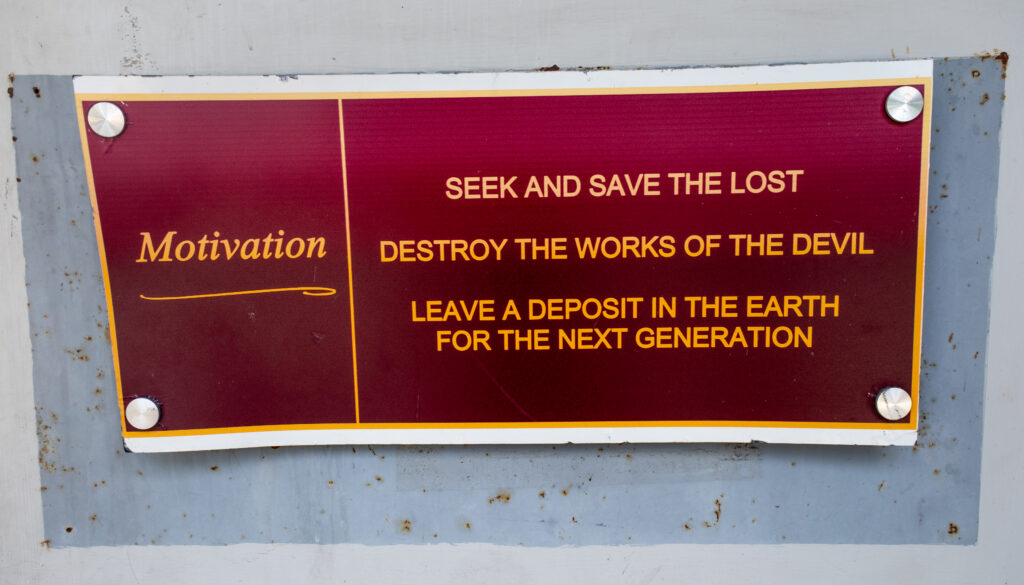
Sheridan loves working with youth and designing in the space. As Taylor put it, the Urban Comuniversity’s holiday designs are “something like you would see in Marshall Fields,” only within the hallways of the former school and staffed by team members who pass out candy. The school, Benjamin O. Davis Developmental Center, served students with disabilities until it was closed and Langston Hughes Elementary was opened in 2009. The building lay empty until the Comuniversity opened.
Sheridan and Taylor work with kids on their homework and take special pride in lending an ear and helping with science fair projects. Sheridan recently helped one girl win at her school with a circuitry project.
“I’m grateful that they are comfortable coming to me,” Sheridan said.
The initial challenge, said Taylor, was bringing in students and establishing community partnerships. Activities like the Comuniversity drill team brought students in, but also tested the nerves of some people in the community.
“We do have a drill team, so throughout the day we do get some noise complaints,” Sheridan said. “To overcome that challenge, we’ve spoken with the neighbors and we’ve come up with a schedule that works for all of us.”
I can attest to the volume and skill of the drill team, personally. I often hear them when I get off the bus and head home from work.
Sheridan said the kids keep her at the Comuniversity. “There are a bunch of children who were like eight, nine [when we opened], and now they’re like nineteen, twenty. Since they’re getting older I’ve been getting invited to a lot of graduations in the last three years.”
“They call themselves OGs, the ones that have been here for so long. Because I noticed that they consider this their spot, I’ve decided to start calling them members,” she said.
According to Taylor, the younger children look up to the “OGs” and feel a sense of well-being knowing that “when I turn fifteen, sixteen, I’m going to be one of them.”
The invitations to graduations are an indication of the level of trust and commitment Sheridan and Taylor have with the kids at the Comuniversity. “I love that they’re able to come to me with all of their different problems,” Sheridan said. They don’t want to tell their parents everything, she said, but “I’m grateful that they trust us.”
Sheridan would like to effect change in the neighborhood by building more community, including by hosting more community events. “In other neighborhoods, I noticed that they’re bigger on hosting events, and you know your neighbors,” she said. “I feel like we have more fights and violence and things like that around here. I really want to stop the violence and reach out to the community and pull them in.”
For the youth who continue to come to the Urban Comuniversity Center, though, Taylor has already noticed an impact. “Some of the changes we’ve seen are that some of the students aren’t as angry as they used to be. I think it was just because they had nowhere to go, nothing to do, or their parents are working all the time; they just want a place to hang out, do their homework, and have someone to talk to,” said Taylor.
Urban Comuniversity Center, 9101 S. Jeffery Blvd. urbancomuniversity.com
✶ ✶ ✶ ✶Dabney Lyles is a longtime South Side resident. This is Dabney’s first piece for the Weekly.

